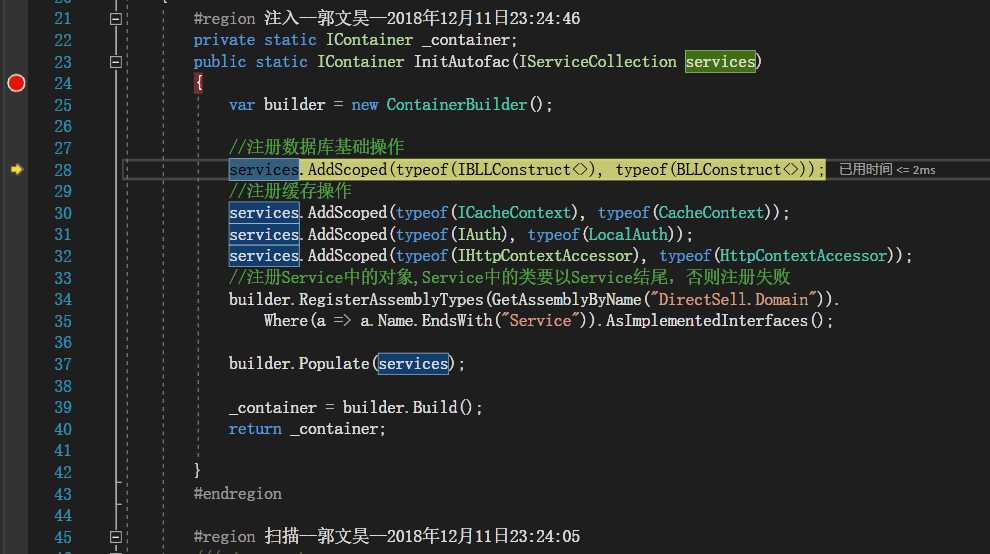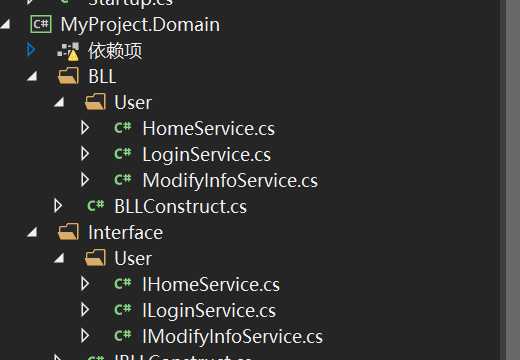标签:sim cache .com 注入 生成 ddt nec 耦合 guid
关于IOC模式和DI技术,网上已经有很多相关的探讨,再次就不过多赘述了,只是简单介绍一下它们的概念
.NetFramewok和.Net Core的区别之一就是.net core所有的实例都是通过依赖注入来创建的。下面介绍一下ASP.NET CORE中如何使用依赖注入
ASP.NET Core本身已经集成了一个轻量级的IOC容器,开发者只需要定义好接口后,在Startup.cs的ConfigureServices方法里使用对应生命周期的绑定方法即可
例:
//注册数据库基础操作 services.AddScoped(typeof(IBLLConstruct<>), typeof(BLLConstruct<>)); //注册缓存操作 services.AddTransient(typeof(ICacheContext), typeof(CacheContext)); services.AddScoped(typeof(IAuth), typeof(LocalAuth)); services.AddSingleton(typeof(IHttpContextAccessor), typeof(HttpContextAccessor));
AddTransient:服务在每次请求时被创建
AddScoped:服务在每次请求时被创建,生命周期横贯整次请求
AddSingleton:顾名思义Singleton(单例),服务在第一次请求时被创建(或者当我们在ConfigureServices中指定创建某一实例并运行方法),其后的每次请求将沿用已创建服务
在这之后,我们便可以将服务通过构造函数注入或者是属性注入的方式注入到Controller,View(通过使用@inject),甚至是Filter中(以前的项目是使用Unity将依赖注入到Filter,个人感觉不如.net core中注入的简洁)。
//数据访问 protected IBLLConstruct<UserInforMations> _repository { get; set; } //缓存 protected ICacheContext _cache { get; set; } protected IAuth _auth { get; set; } public LoginService(IBLLConstruct<UserInforMations> repository, ICacheContext cache, IAuth auth) { this._cache = cache; this._repository = repository; this._auth = auth; }
流程大概就是这样,我们启动项目来看一下它的执行顺序
(1)容器创建实例

(2)构造函数获取实例

除了ASP.NETCore自带的IOC容器外,我们还可以使用其他成熟的DI框架,如Autofac,StructureMap等(本人只用过Unity,Autofac)。
(1)安装autofac

(2)创建容器并注册依赖
修改Startup.cs中ConfigureServices方法 不要忘了将ConfigureServices的返回值修改为IServiceProvider
public IServiceProvider ConfigureServices(IServiceCollection services) { services.Configure<CookiePolicyOptions>(options => { // This lambda determines whether user consent for non-essential cookies is needed for a given request. options.CheckConsentNeeded = context => true; options.MinimumSameSitePolicy = SameSiteMode.None; }); services.AddMvc().SetCompatibilityVersion(CompatibilityVersion.Version_2_1); services.AddDbContext<DirectSellContext>(options => options.UseSqlServer(Configuration.GetConnectionString("DBContext"), b => b.UseRowNumberForPaging())); //使用AutoFac进行注入 return new AutofacServiceProvider(AutofacExt.InitAutofac(services)); }
(3)在AutofacExt类中创建容器并注册依赖
private static IContainer _container; public static IContainer InitAutofac(IServiceCollection services) { var builder = new ContainerBuilder(); builder.RegisterType<GuidTransientAppService>().As<IGuidTransientAppService>(); builder.RegisterType<GuidScopedAppService>().As<IGuidScopedAppService>().InstancePerLifetimeScope(); builder.RegisterType<GuidSingletonAppService>().As<IGuidSingletonAppService>().SingleInstance(); builder.Populate(services); _container = builder.Build(); return _container; }
InstancePerLifetimeScope:同一个Lifetime生成的对象是同一个实例
SingleInstance:单例模式,每次调用,都会使用同一个实例化的对象;每次都用同一个对象;
InstancePerDependency:默认模式,每次调用,都会重新实例化对象;每次请求都创建一个新的对象;
(4)AutoFac批量注册服务
通过以上方式可以实现注入,但是我们每定义一个接口,都要在AutoFac中注册一次,可以使用RegisterAssemblyTypes来避免这种重复劳动
反射获取程序集
/// <summary> /// 根据程序集名称获取程序集 /// </summary> /// <param name="AssemblyName">程序集名称</param> /// <returns></returns> public static Assembly GetAssemblyByName(String AssemblyName) { return Assembly.Load(AssemblyName); }
批量注册
//注册Service中的对象,Service中的类要以Service结尾,否则注册失败 builder.RegisterAssemblyTypes(GetAssemblyByName("MyProject.Domain")). Where(a => a.Name.EndsWith("Service")).AsImplementedInterfaces();
这样就实现了Domain层中以Service结尾的接口批量注册 命名格式如下:

标签:sim cache .com 注入 生成 ddt nec 耦合 guid
原文地址:https://www.cnblogs.com/quebra/p/10203125.html